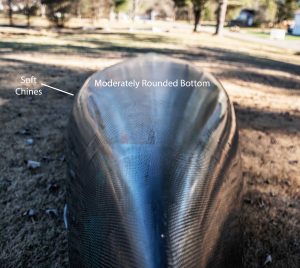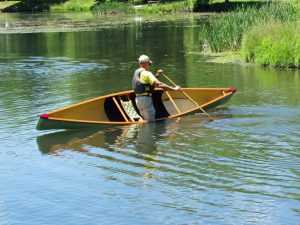By Marc Ornstein
I’ve often heard from folks who ask something to the effect of “I want to buy a FreeStyle canoe. What’s the best boat?”. After determining their (the paddler’s) size, I could simply suggest several specific boats, but to answer appropriately the question needs to be examined more closely.
Is the questioner interested primarily in interpretive FreeStyle, i.e., paddling routines, choreographed to music? Is he/she interested in functional FreeStyle i.e., using FreeStyle technique to traverse meandering streams? Perhaps it’s intended to be more of a touring/tripping canoe with “FreeStyle” tendencies. What skillsets does the questioner have or be willing to work toward? Perhaps budget is an issue. Recommending a $4000.00 craft to an aspiring paddler with limited resources may not be helpful.
FreeStyle is a canoeing discipline that emphasizes the interaction between the boat, body, and the blade. It consists of various maneuvers and combinations of maneuvers which when combined with heel (leaning the canoe laterally) and pitch (weighting the leading stem down) greatly enhance the maneuverability of most any hull. Interpretive FreeStyle is perhaps the most extreme form of the discipline, where 180-degree (or greater) turns are the norm. Generally, an interpretive routine consists of many such turns, often linked together with no more than a paddle stroke or two between them. Functional FreeStyle uses similar techniques to easily maneuver on tight twisty creeks or along other complex shorelines. While use of these techniques will enhance the performance of most any canoe, hulls with certain characteristics will be more responsive.
Let’s explore some of these factors.
 A canoe to be used primarily for interpretive or functional FreeStyle should have a moderately rounded bottom, soft chines, and modest rocker.
A canoe to be used primarily for interpretive or functional FreeStyle should have a moderately rounded bottom, soft chines, and modest rocker.  These characteristics allow the hull to be heeled and or pitched easily and smoothly. The canoe should be narrow enough so that the paddler can (when centered in the boat) readily reach across the gunwales and hold the paddle shaft vertically, with the blade fully submerged. It must be wide enough to accommodate the paddler’s feet and legs (from toes to knees) when transverse. The hull depth should be such that the seat may be mounted high enough for comfortable kneeling with adequate foot clearance. Modest tumblehome will allow for adequate room between the paddler’s shaft hand and the gunwale. Increased tumblehome will allow the canoe to be heeled a bit further, without taking water over the rail. Overall lengths of 12’-14’ are common for solo canoes, and 15’-16’ for tandems. Lastly, a hull used primarily for FreeStyle should be symmetrical. Many skilled paddlers find these same canoes quite satisfying as day and weekend trippers.
These characteristics allow the hull to be heeled and or pitched easily and smoothly. The canoe should be narrow enough so that the paddler can (when centered in the boat) readily reach across the gunwales and hold the paddle shaft vertically, with the blade fully submerged. It must be wide enough to accommodate the paddler’s feet and legs (from toes to knees) when transverse. The hull depth should be such that the seat may be mounted high enough for comfortable kneeling with adequate foot clearance. Modest tumblehome will allow for adequate room between the paddler’s shaft hand and the gunwale. Increased tumblehome will allow the canoe to be heeled a bit further, without taking water over the rail. Overall lengths of 12’-14’ are common for solo canoes, and 15’-16’ for tandems. Lastly, a hull used primarily for FreeStyle should be symmetrical. Many skilled paddlers find these same canoes quite satisfying as day and weekend trippers.
Canoes designed for touring/tripping may also be fine FreeStyle boats. These hulls will likely be a bit longer and have a bit less rocker. These boats will be somewhat faster and easier to hold on course though they may not be quite as nimble when it comes to tight turns. Many modern touring hulls are asymmetrical, which for the most part refers to the stern being a bit skegged or pinched. While a skegged stern resists turning while the hull is level, its effect is less when heeled. All of the various FreeStyle techniques and maneuvers are quite functional with these boats.
A top of the line, ultra-light weight carbon fiber or Kevlar hull may be enticing but a similar hull of heavier and less expensive fiberglass may perform nearly as well. A Royalex or similar plastic hull may be another step down in price but with the advantage of durability, especially if one paddles in shallow and or rocky waters.

At a paddling event some years ago, I had the opportunity to paddle a brand-new Nomad from Colden Canoe. This was a Dave Yost design, previously manufactured by Curtis Canoes. The boat was quite fast and tracked nicely, but when put through a series of FreeStyle maneuvers and heeled/pitched smartly, it turned beautifully. Upon my return to shore, I commented to Paul Meyer (then owner of Colden Canoe) that it was a fine tripper and a lot of fun. Later that day I bumped into Dave Yost and asked him what he had intended when he designed the Nomad. His response was, and I paraphrase, “We wanted a fast tripper that would be fun to play with once you reached camp.” Clearly, he nailed it. ![]() Unfortunately, that Nomad is no longer in production and my understanding is that the mold no longer exists.
Unfortunately, that Nomad is no longer in production and my understanding is that the mold no longer exists.
FreeStyle is a skillset which can be applied, more or less, to most canoeing disciplines. Skilled trippers, touring, whitewater paddlers and even top marathon racers often employ these techniques. So, do you want to buy a FreeStyle canoe? Maybe but how you define your needs and the size of your wallet will define the correct boat for you.